wheel JEEP COMPASS 2012 1.G Owner's Manual
[x] Cancel search | Manufacturer: JEEP, Model Year: 2012, Model line: COMPASS, Model: JEEP COMPASS 2012 1.GPages: 108, PDF Size: 4.03 MB
Page 66 of 108
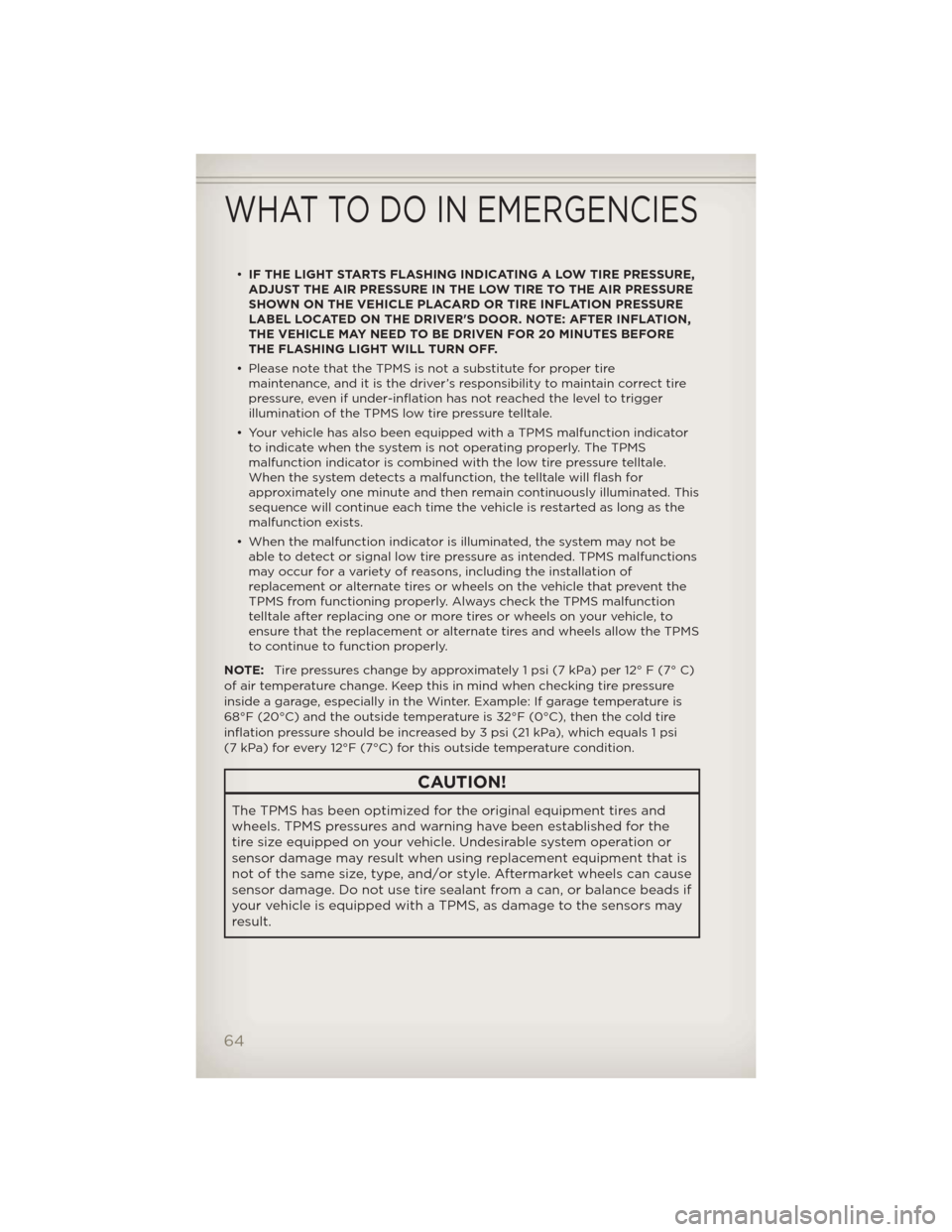
•IF THE LIGHT STARTS FLASHING INDICATING A LOW TIRE PRESSURE,
ADJUST THE AIR PRESSURE IN THE LOW TIRE TO THE AIR PRESSURE
SHOWN ON THE VEHICLE PLACARD OR TIRE INFLATION PRESSURE
LABEL LOCATED ON THE DRIVER'S DOOR. NOTE: AFTER INFLATION,
THE VEHICLE MAY NEED TO BE DRIVEN FOR 20 MINUTES BEFORE
THE FLASHING LIGHT WILL TURN OFF.
• Please note that the TPMS is not a substitute for proper tire
maintenance, and it is the driver’s responsibility to maintain correct tire
pressure, even if under-inflation has not reached the level to trigger
illumination of the TPMS low tire pressure telltale.
• Your vehicle has also been equipped with a TPMS malfunction indicator
to indicate when the system is not operating properly. The TPMS
malfunction indicator is combined with the low tire pressure telltale.
When the system detects a malfunction, the telltale will flash for
approximately one minute and then remain continuously illuminated. This
sequence will continue each time the vehicle is restarted as long as the
malfunction exists.
• When the malfunction indicator is illuminated, the system may not be
able to detect or signal low tire pressure as intended. TPMS malfunctions
may occur for a variety of reasons, including the installation of
replacement or alternate tires or wheels on the vehicle that prevent the
TPMS from functioning properly. Always check the TPMS malfunction
telltale after replacing one or more tires or wheels on your vehicle, to
ensure that the replacement or alternate tires and wheels allow the TPMS
to continue to function properly.
NOTE:Tire pressures change by approximately 1 psi (7 kPa) per 12° F (7° C)
of air temperature change. Keep this in mind when checking tire pressure
inside a garage, especially in the Winter. Example: If garage temperature is
68°F (20°C) and the outside temperature is 32°F (0°C), then the cold tire
inflation pressure should be increased by 3 psi (21 kPa), which equals 1 psi
(7 kPa) for every 12°F (7°C) for this outside temperature condition.
CAUTION!
The TPMS has been optimized for the original equipment tires and
wheels. TPMS pressures and warning have been established for the
tire size equipped on your vehicle. Undesirable system operation or
sensor damage may result when using replacement equipment that is
not of the same size, type, and/or style. Aftermarket wheels can cause
sensor damage. Do not use tire sealant from a can, or balance beads if
your vehicle is equipped with a TPMS, as damage to the sensors may
result.
WHAT TO DO IN EMERGENCIES
64
Page 71 of 108
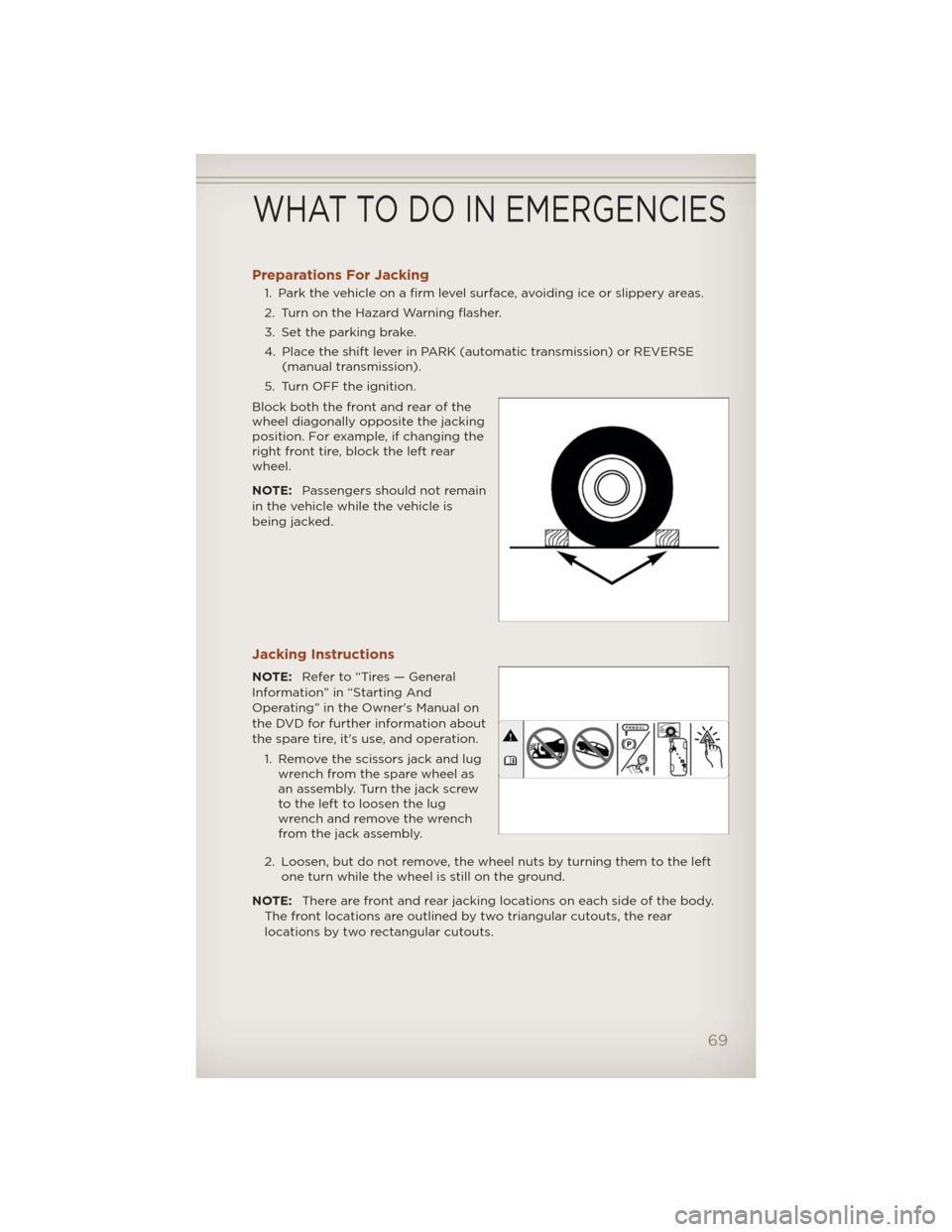
Preparations For Jacking
1. Park the vehicle on a firm level surface, avoiding ice or slippery areas.
2. Turn on the Hazard Warning flasher.
3. Set the parking brake.
4. Place the shift lever in PARK (automatic transmission) or REVERSE
(manual transmission).
5. Turn OFF the ignition.
Block both the front and rear of the
wheel diagonally opposite the jacking
position. For example, if changing the
right front tire, block the left rear
wheel.
NOTE:Passengers should not remain
in the vehicle while the vehicle is
being jacked.
Jacking Instructions
NOTE:Refer to “Tires — General
Information” in “Starting And
Operating” in the Owner's Manual on
the DVD for further information about
the spare tire, it's use, and operation.
1. Remove the scissors jack and lug
wrench from the spare wheel as
an assembly. Turn the jack screw
to the left to loosen the lug
wrench and remove the wrench
from the jack assembly.
2. Loosen, but do not remove, the wheel nuts by turning them to the left
one turn while the wheel is still on the ground.
NOTE:There are front and rear jacking locations on each side of the body.
The front locations are outlined by two triangular cutouts, the rear
locations by two rectangular cutouts.
WHAT TO DO IN EMERGENCIES
69
Page 72 of 108
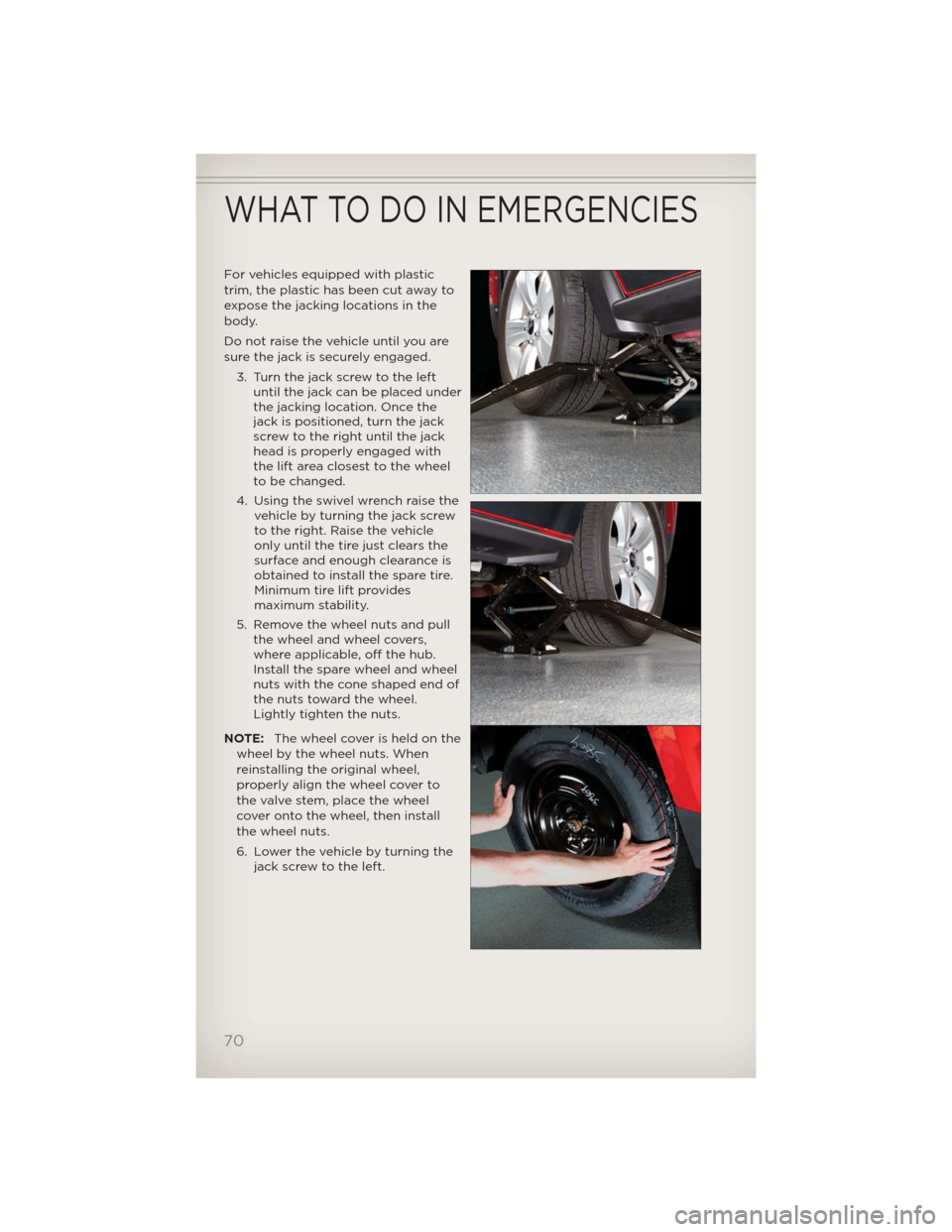
For vehicles equipped with plastic
trim, the plastic has been cut away to
expose the jacking locations in the
body.
Do not raise the vehicle until you are
sure the jack is securely engaged.
3. Turn the jack screw to the left
until the jack can be placed under
the jacking location. Once the
jack is positioned, turn the jack
screw to the right until the jack
head is properly engaged with
the lift area closest to the wheel
to be changed.
4. Using the swivel wrench raise the
vehicle by turning the jack screw
to the right. Raise the vehicle
only until the tire just clears the
surface and enough clearance is
obtained to install the spare tire.
Minimum tire lift provides
maximum stability.
5. Remove the wheel nuts and pull
the wheel and wheel covers,
where applicable, off the hub.
Install the spare wheel and wheel
nuts with the cone shaped end of
the nuts toward the wheel.
Lightly tighten the nuts.
NOTE:The wheel cover is held on the
wheel by the wheel nuts. When
reinstalling the original wheel,
properly align the wheel cover to
the valve stem, place the wheel
cover onto the wheel, then install
the wheel nuts.
6. Lower the vehicle by turning the
jack screw to the left.
WHAT TO DO IN EMERGENCIES
70
Page 73 of 108
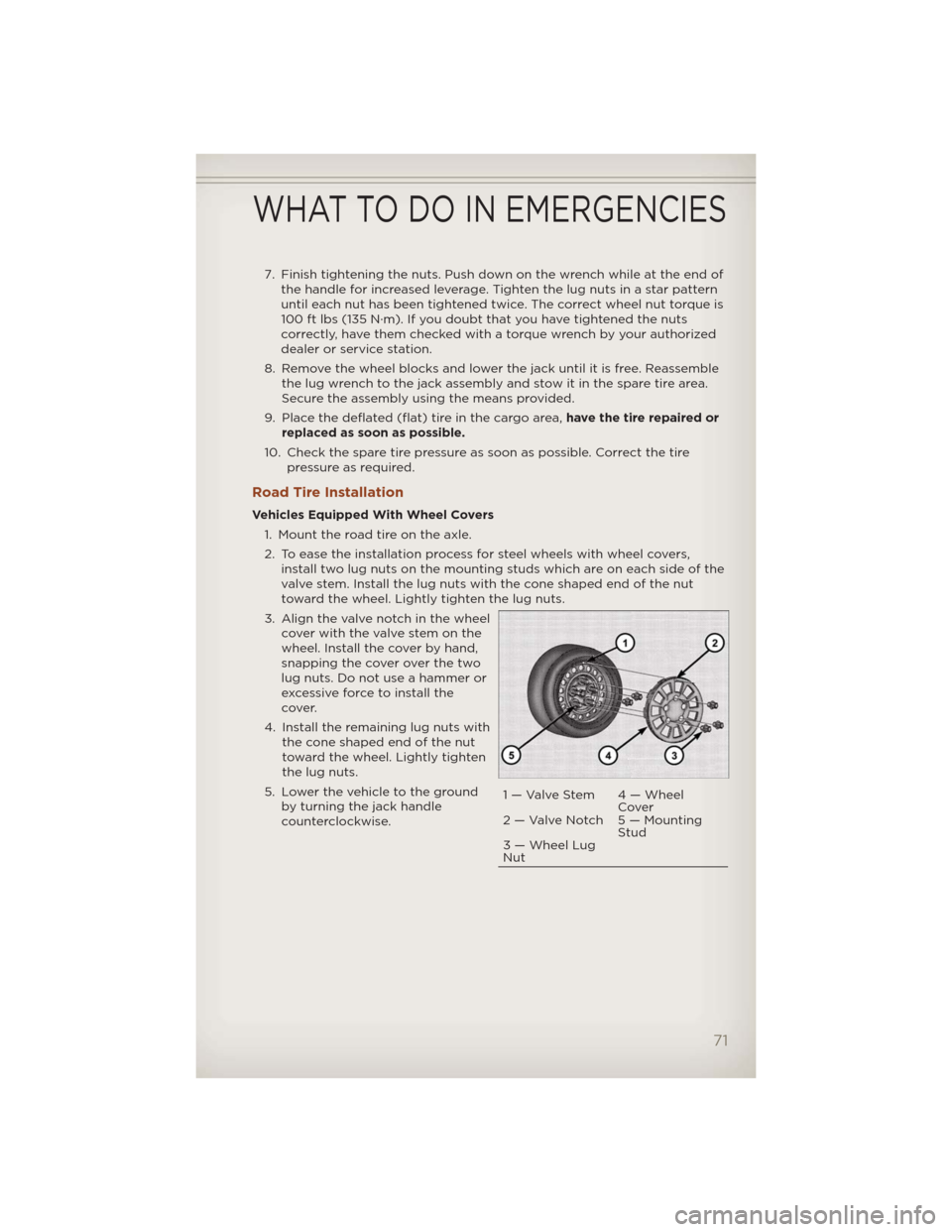
7. Finish tightening the nuts. Push down on the wrench while at the end of
the handle for increased leverage. Tighten the lug nuts in a star pattern
until each nut has been tightened twice. The correct wheel nut torque is
100 ft lbs (135 N·m). If you doubt that you have tightened the nuts
correctly, have them checked with a torque wrench by your authorized
dealer or service station.
8. Remove the wheel blocks and lower the jack until it is free. Reassemble
the lug wrench to the jack assembly and stow it in the spare tire area.
Secure the assembly using the means provided.
9. Place the deflated (flat) tire in the cargo area,have the tire repaired or
replaced as soon as possible.
10. Check the spare tire pressure as soon as possible. Correct the tire
pressure as required.
Road Tire Installation
Vehicles Equipped With Wheel Covers
1. Mount the road tire on the axle.
2. To ease the installation process for steel wheels with wheel covers,
install two lug nuts on the mounting studs which are on each side of the
valve stem. Install the lug nuts with the cone shaped end of the nut
toward the wheel. Lightly tighten the lug nuts.
3. Align the valve notch in the wheel
cover with the valve stem on the
wheel. Install the cover by hand,
snapping the cover over the two
lug nuts. Do not use a hammer or
excessive force to install the
cover.
4. Install the remaining lug nuts with
the cone shaped end of the nut
toward the wheel. Lightly tighten
the lug nuts.
5. Lower the vehicle to the ground
by turning the jack handle
counterclockwise.
1 — Valve Stem 4 — Wheel
Cover
2 — Valve Notch 5 — Mounting
Stud
3 — Wheel Lug
Nut
WHAT TO DO IN EMERGENCIES
71
Page 74 of 108
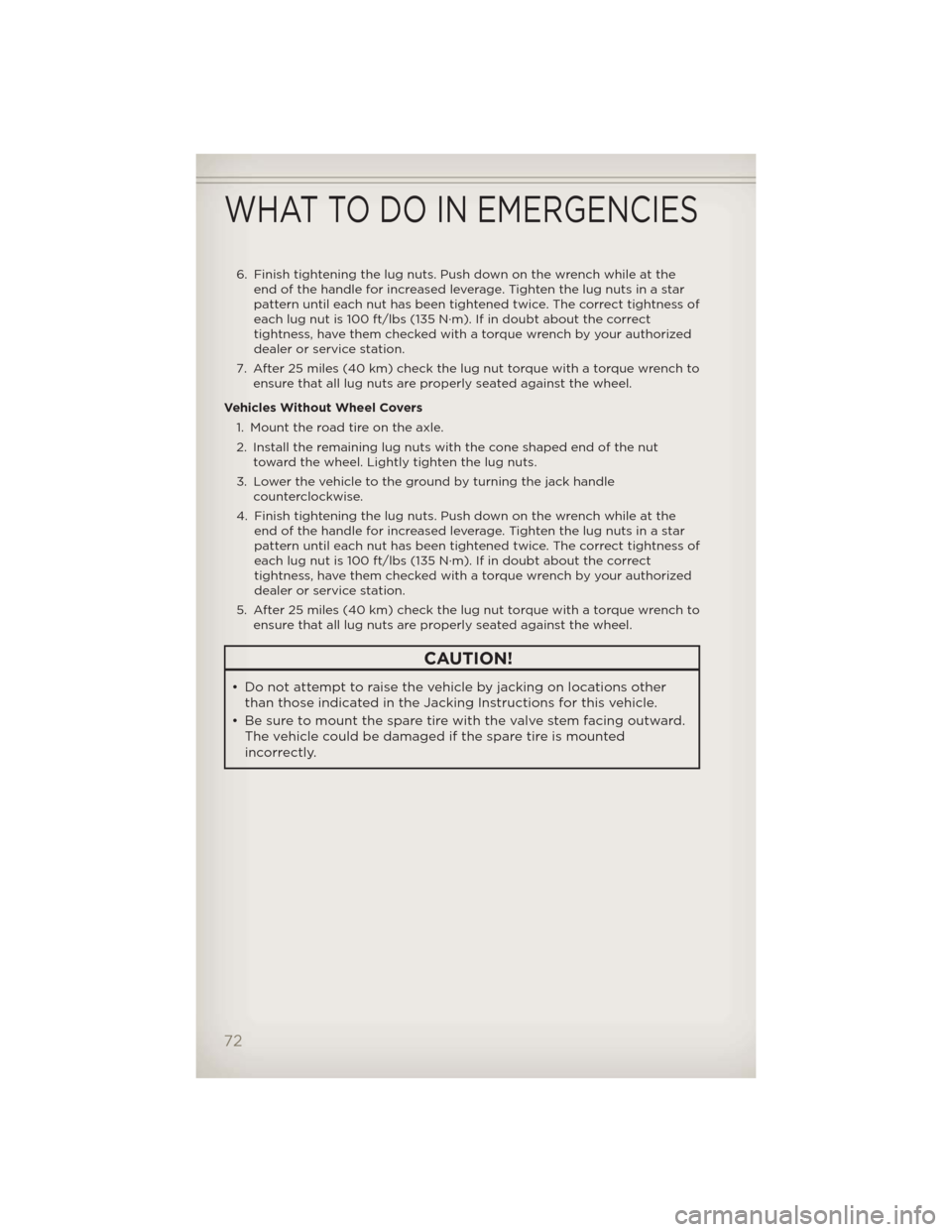
6. Finish tightening the lug nuts. Push down on the wrench while at the
end of the handle for increased leverage. Tighten the lug nuts in a star
pattern until each nut has been tightened twice. The correct tightness of
each lug nut is 100 ft/lbs (135 N·m). If in doubt about the correct
tightness, have them checked with a torque wrench by your authorized
dealer or service station.
7. After 25 miles (40 km) check the lug nut torque with a torque wrench to
ensure that all lug nuts are properly seated against the wheel.
Vehicles Without Wheel Covers
1. Mount the road tire on the axle.
2. Install the remaining lug nuts with the cone shaped end of the nut
toward the wheel. Lightly tighten the lug nuts.
3. Lower the vehicle to the ground by turning the jack handle
counterclockwise.
4. Finish tightening the lug nuts. Push down on the wrench while at the
end of the handle for increased leverage. Tighten the lug nuts in a star
pattern until each nut has been tightened twice. The correct tightness of
each lug nut is 100 ft/lbs (135 N·m). If in doubt about the correct
tightness, have them checked with a torque wrench by your authorized
dealer or service station.
5. After 25 miles (40 km) check the lug nut torque with a torque wrench to
ensure that all lug nuts are properly seated against the wheel.
CAUTION!
• Do not attempt to raise the vehicle by jacking on locations other
than those indicated in the Jacking Instructions for this vehicle.
• Be sure to mount the spare tire with the valve stem facing outward.
The vehicle could be damaged if the spare tire is mounted
incorrectly.
WHAT TO DO IN EMERGENCIES
72
Page 75 of 108
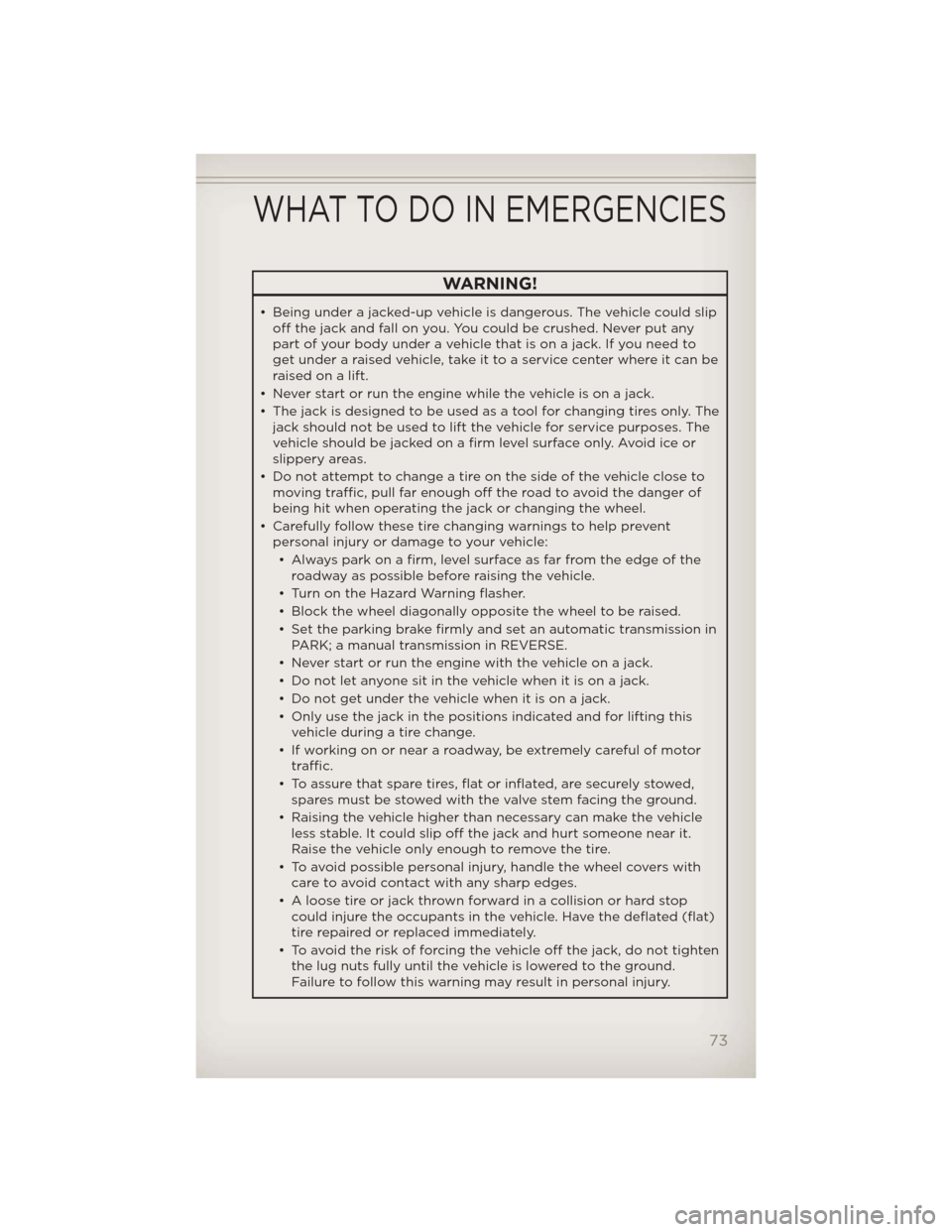
WARNING!
• Being under a jacked-up vehicle is dangerous. The vehicle could slip
off the jack and fall on you. You could be crushed. Never put any
part of your body under a vehicle that is on a jack. If you need to
get under a raised vehicle, take it to a service center where it can be
raised on a lift.
• Never start or run the engine while the vehicle is on a jack.
• The jack is designed to be used as a tool for changing tires only. The
jack should not be used to lift the vehicle for service purposes. The
vehicle should be jacked on a firm level surface only. Avoid ice or
slippery areas.
• Do not attempt to change a tire on the side of the vehicle close to
moving traffic, pull far enough off the road to avoid the danger of
being hit when operating the jack or changing the wheel.
• Carefully follow these tire changing warnings to help prevent
personal injury or damage to your vehicle:
• Alwayspark on a firm, level surface as far from the edge of the
roadway as possible before raising the vehicle.
• Turn on the Hazard Warning flasher.
• Block the wheel diagonally opposite the wheel to be raised.
• Set the parking brake firmly and set an automatic transmission in
PARK; a manual transmission in REVERSE.
• Never start or run the engine with the vehicle on a jack.
• Do not let anyone sit in the vehicle when it is on a jack.
• Do not get under the vehicle when it is on a jack.
• Only use the jack in the positions indicated and for lifting this
vehicle during a tire change.
• If working on or near a roadway, be extremely careful of motor
traffic.
• To assure that spare tires, flat or inflated, are securely stowed,
spares must be stowed with the valve stem facing the ground.
• Raising the vehicle higher than necessary can make the vehicle
less stable. It could slip off the jack and hurt someone near it.
Raise the vehicle only enough to remove the tire.
• To avoid possible personal injury, handle the wheel covers with
care to avoid contact with any sharp edges.
• A loose tire or jack thrown forward in a collision or hard stop
could injure the occupants in the vehicle. Have the deflated (flat)
tire repaired or replaced immediately.
• To avoid the risk of forcing the vehicle off the jack, do not tighten
the lug nuts fully until the vehicle is lowered to the ground.
Failure to follow this warning may result in personal injury.
WHAT TO DO IN EMERGENCIES
73
Page 79 of 108
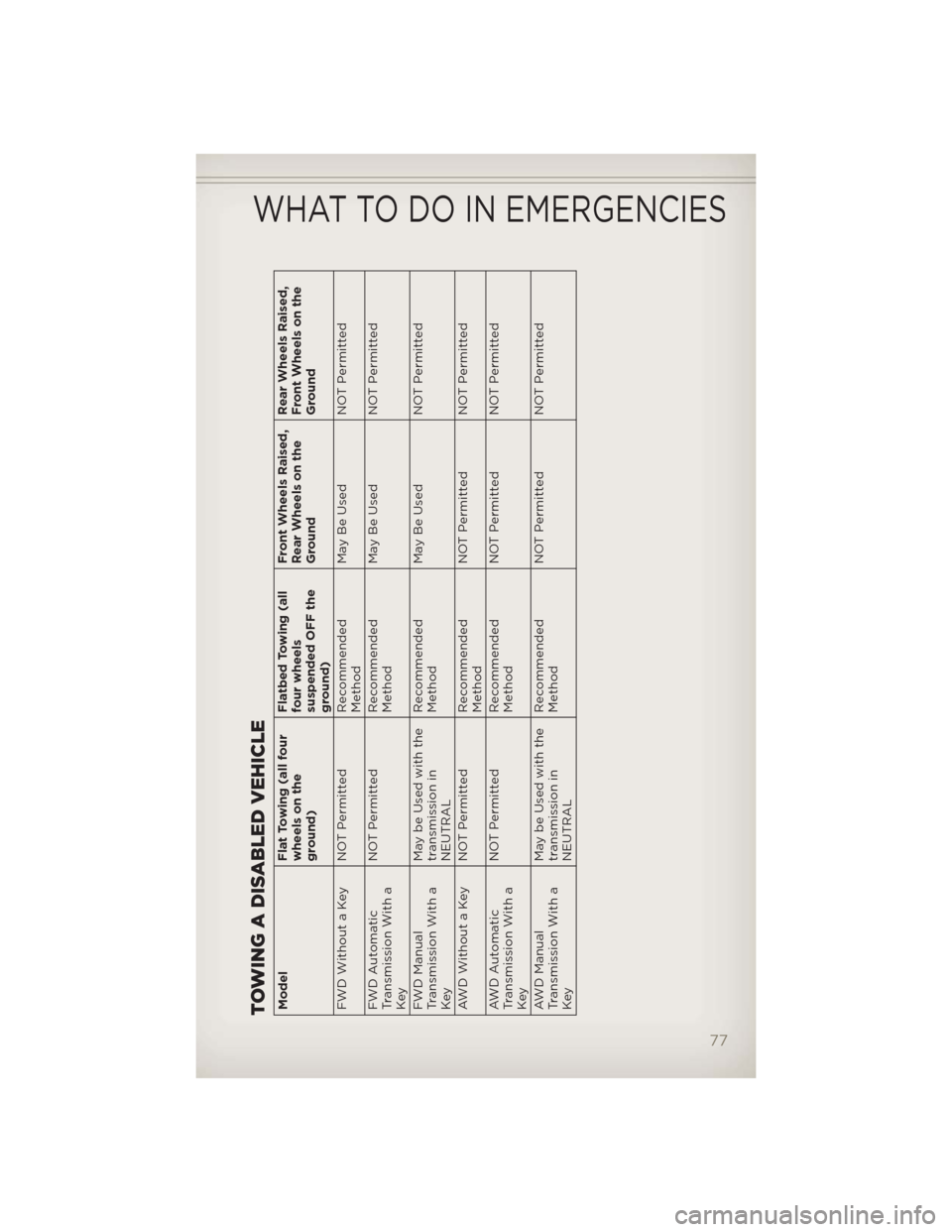
TOWING A DISABLED VEHICLEModelFlat Towing (all four
wheels on the
ground)Flatbed Towing (all
four wheels
suspended OFF the
ground)Front Wheels Raised,
Rear Wheels on the
GroundRear Wheels Raised,
Front Wheels on the
Ground
FWD Without a Key NOT Permitted Recommended
MethodMay Be Used NOT Permitted
FWD Automatic
Transmission With a
KeyNOT Permitted Recommended
MethodMay Be Used NOT Permitted
FWD Manual
Transmission With a
KeyMay be Used with the
transmission in
NEUTRALRecommended
MethodMay Be Used NOT Permitted
AWD Without a Key NOT Permitted Recommended
MethodNOT Permitted NOT Permitted
AWD Automatic
Transmission With a
KeyNOT Permitted Recommended
MethodNOT Permitted NOT Permitted
AWD Manual
Transmission With a
KeyMay be Used with the
transmission in
NEUTRALRecommended
MethodNOT Permitted NOT Permitted
WHAT TO DO IN EMERGENCIES
77
Page 80 of 108
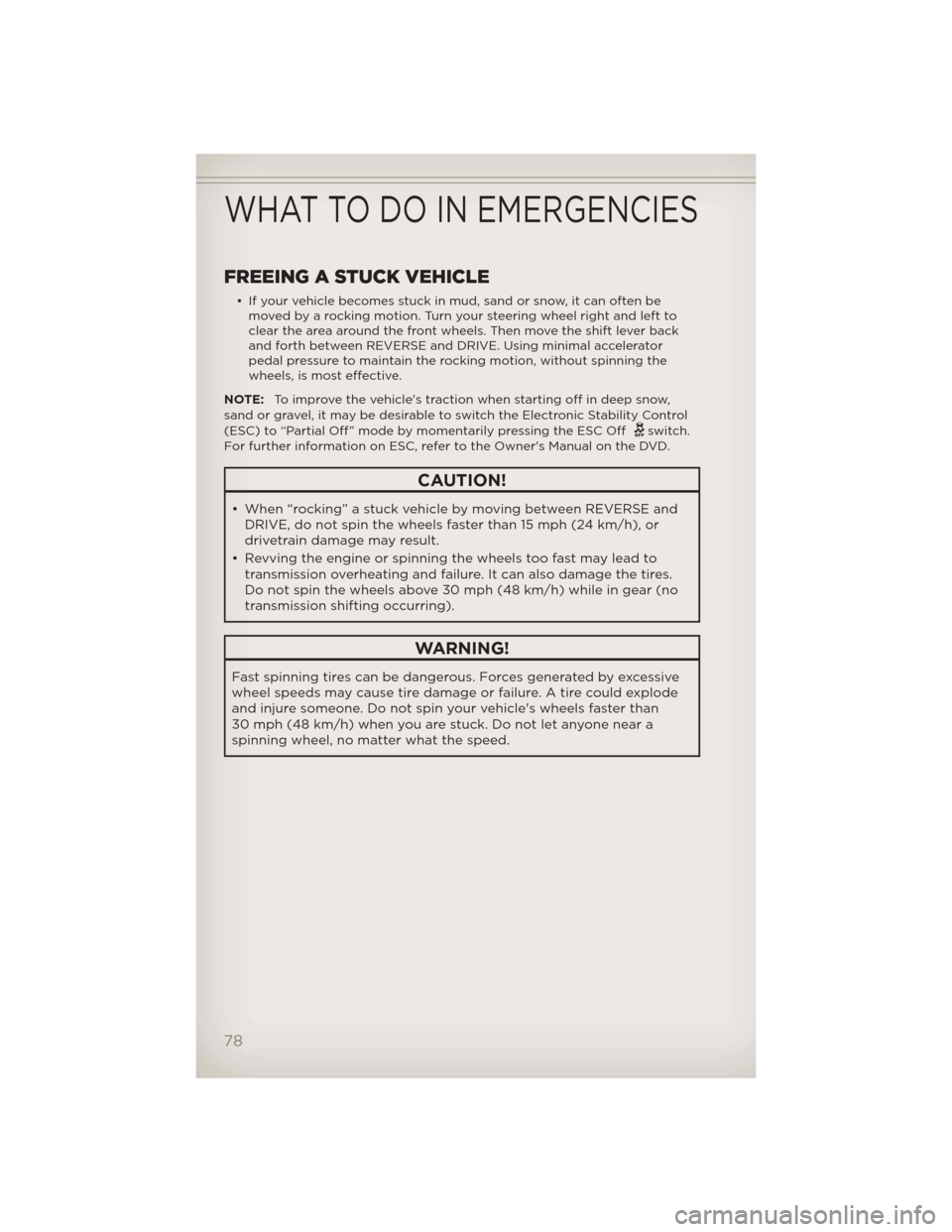
FREEING A STUCK VEHICLE
• If your vehicle becomes stuck in mud, sand or snow, it can often be
moved by a rocking motion. Turn your steering wheel right and left to
clear the area around the front wheels. Then move the shift lever back
and forth between REVERSE and DRIVE. Using minimal accelerator
pedal pressure to maintain the rocking motion, without spinning the
wheels, is most effective.
NOTE:To improve the vehicle's traction when starting off in deep snow,
sand or gravel, it may be desirable to switch the Electronic Stability Control
(ESC) to “Partial Off” mode by momentarily pressing the ESC Off
switch.
For further information on ESC, refer to the Owner's Manual on the DVD.
CAUTION!
• When “rocking” a stuck vehicle by moving between REVERSE and
DRIVE, do not spin the wheels faster than 15 mph (24 km/h), or
drivetrain damage may result.
• Revving the engine or spinning the wheels too fast may lead to
transmission overheating and failure. It can also damage the tires.
Do not spin the wheels above 30 mph (48 km/h) while in gear (no
transmission shifting occurring).
WARNING!
Fast spinning tires can be dangerous. Forces generated by excessive
wheel speeds may cause tire damage or failure. A tire could explode
and injure someone. Do not spin your vehicle's wheels faster than
30 mph (48 km/h) when you are stuck. Do not let anyone near a
spinning wheel, no matter what the speed.
WHAT TO DO IN EMERGENCIES
78
Page 86 of 108
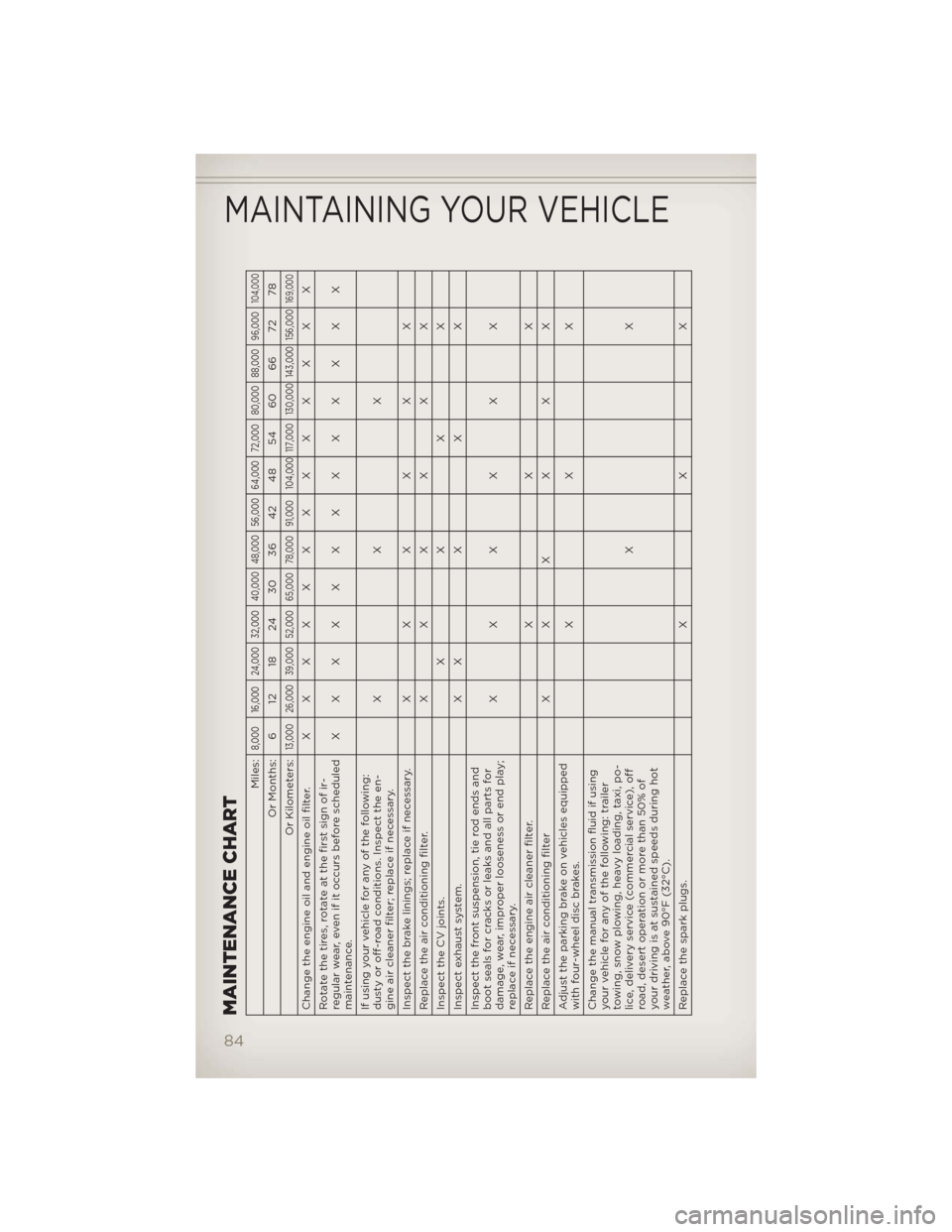
MAINTENANCE CHART
Miles:
8,000 16,000 24,000 32,000 40,000 48,000 56,000 64,000 72,000 80,000 88,000 96,000
104,000
Or Months: 6 12 18 24 30 36 42 48 54 60 66 72 78
Or Kilometers:
13,000 26,000 39,000 52,000 65,000 78,000 91,000 104,000 117,000 130,000 143,000 156,000
169,000
Change the engine oil and engine oil filter.XXXXXXXXXXXXX
Rotate the tires, rotate at the first sign of ir-
regular wear, even if it occurs before scheduled
maintenance.XXXXXXXXXXXXX
If using your vehicle for any of the following:
dusty or off-road conditions. Inspect the en-
gine air cleaner filter; replace if necessary.XXX
Inspect the brake linings; replace if necessary. X XXXXX
Replace the air conditioning filter. X XXXXX
InspecttheCVjoints. XXXX
Inspectexhaustsystem. XXXXX
Inspect the front suspension, tie rod ends and
boot seals for cracks or leaks and all parts for
damage, wear, improper looseness or end play;
replace if necessary.XXXXXX
Replace the engine air cleaner filter. X X X
Replace the air conditioning filter X X X X X X
Adjust the parking brake on vehicles equipped
with four-wheel disc brakes.XXX
Change the manual transmission fluid if using
your vehicle for any of the following: trailer
towing, snow plowing, heavy loading, taxi, po-
lice, delivery service (commercial service), off
road, desert operation or more than 50% of
your driving is at sustained speeds during hot
weather, above 90°F (32°C).XX
Replace the spark plugs. X X X
MAINTAINING YOUR VEHICLE
84
Page 92 of 108

WHEEL AND WHEEL TRIM CARE
• All wheels and wheel trim, especially aluminum and chrome plated
wheels, should be cleaned regularly with a mild soap and water to
prevent corrosion.
• To remove heavy soil and/or excessive brake dust, use MOPAR® Wheel
Cleaner or equivalent or select a non-abrasive, non-acidic cleaner.
CAUTION!
Do not use scouring pads, steel wool, a bristle brush, or metal
polishes. Do not use oven cleaner. These products may damage the
wheel's protective finish. Avoid automatic car washes that use acidic
solutions or harsh brushes that may damage the wheel's protective
finish. Only MOPAR® Wheel Cleaner or equivalent is recommended.
EXTERIOR BULBS
LIGHT BULBS – Exterior Bulb Number
Low Beam Headlamp H11
High Beam Headlamp 9005
Front Park/Turn Signal 7444NA
Front Side Marker Lamp 194
Front Fog Lamp H11
Center High Mounted Stop Lamp
(CHMSL)LED Assembly (Serviced at
Authorized Dealer)
Rear Tail/Stop Lamp LED (Serviced at Authorized Dealer)
Rear Turn Lamp 7440NA (WY21W) Amber
Backup Lamp 7440 (W21W) Crystal
License Lamp W5W
MAINTAINING YOUR VEHICLE
90